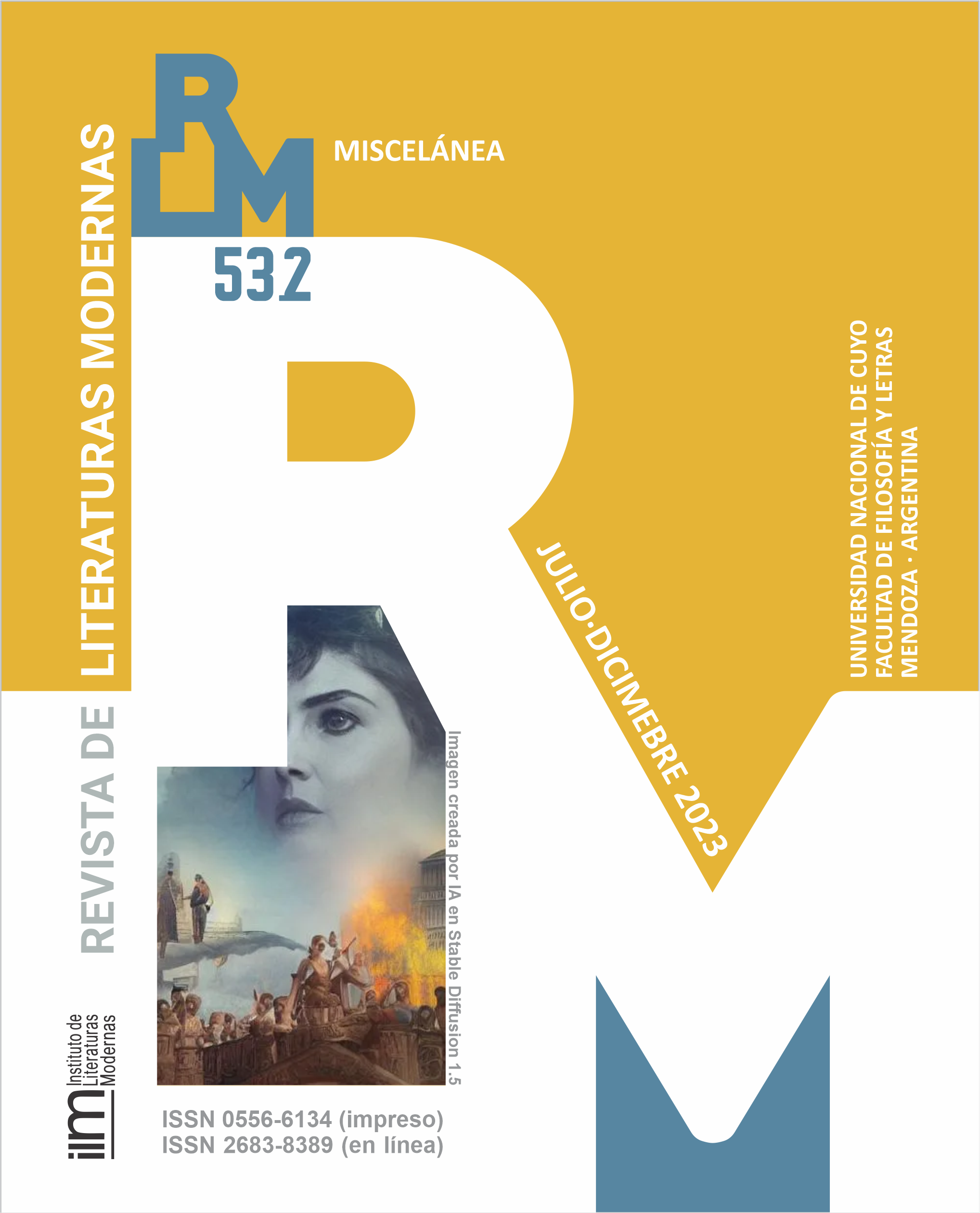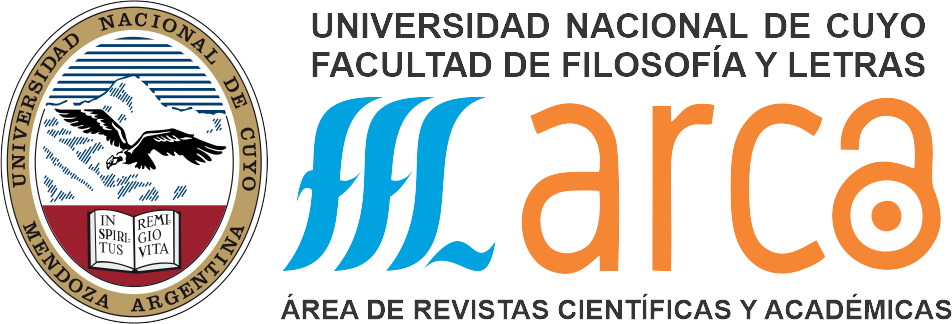The traces of violence in the mythical character of Medea in Polifonía by Diana de Paco Serrano
Keywords:
Medea, Reception, Polifonía, Paco Serrano, ViolenceAbstract
Perhaps Polifonía (2001) constitutes one of the outstanding works of the contemporary Spanish literature that uses the Greek myths as a sublayer background of the dramaturgy. The author, Diana de Paco Serrano gives voice to four women highly known in the ancient times. Penelope, Phaedra, Clytemnestra and Medea open dialogues among themselves and with their pairs, the men who have marked them in the past. Paco Serrano tries to re-code, in fifteen scenes of a harmonious piece, the role of the woman starting from the guilt, key of the play, and thus she tries to reconstruct the tragic fate of each heroine. From the psychological conscience they are located in an imaginary prison out of time and space, and as prisoners of a role they revive the myth that belongs to them from a meta-theatrical game. So, myth, territory and violence are presented from a feminine perspective.
Downloads
References
Bachelard, G. (1961). La poétique de l`espace. Presses Universitaires de France.
Barlow, S. (1989). Stereotype and reversal in Euripides´ Medea. G&R, vol. 36 (2), 158-171.
Barthes, R. (1993). Fragmentos de un discurso amoroso. Siglo XXI editores.
Bassnett, S. (1993). Comparative Literature, A critical Introduction. Blackwell.
Biglieri, A. A. (2017). Los espacios abiertos de la pampa argentina. 452ºF. Revista de Teoría de la literatura y Literatura Comparada, vol. 16, 132-57.
Boehm, I. (2015). Pur concept, élément naturel ou réalité édifiée de main d’homme ? À propos du vocabulaire de la frontière en grec ancien. Cahiers des études anciennes, LII, 19-45. http://etudesanciennes.revues.org/822.
Burket, W., Girard, R. y Smith, J. (1987). Ritual Killing and Cultural Formation. Stanford University Press.
Cammarata, E. B. (2006). El turismo como práctica social y su papel en la apropiación y consolidación del territorio en M. Geraiges de Lemos, M. Arroyo y M. L. Silveira (eds.), América Latina: cidade, campo e turismo (pp.351-366). Clacso, Consejo Latinoamericano de Ciencias Sociales.
De Pourcq, M. (2012). Classical Reception Studies: Reconceptualizing the Study of the Classical Tradition. The International Journal of the Humanities 9.4, 219-226.
Euripides. (1994). Cyclops – Alcestis – Medea (trad. D. Kovacs). Harvard University Press.
Eurípides. (1995). Tragedias. Medea – Hipólito – Andrómaca. Planeta D’Agostini.
Eurípides. (2000). Tragedias. Alcestes – Medea – Los Heraclidas – Hipólito – Andrómaca – Hécuba. Gredos.
Eurípides. (2002). Euripides Medea. Cambridge University Press.
Eurípides. (2007). Tragedias (trad. J. T. Nápoli). Colihue Clásica.
Femenías, M. L. (2013). Violencias cotidianas (en las vidas de las mujeres) Los ríos subterráneos. Ediciones prohistoria. Vol I.
Floek, W. (2009). Introducción a Polifonía. In Diana de Paco Serrano. Polifonía. Universidad de Murcia.
Foucault, M. (2000). Los anormales. Fondo de cultura económica.
Gambon, L. (2009). Crisis de fertilidad en la tragedia: el imaginario de la apaidía en Eurípides, Svpplementvm II (pp. 109-147), Nova Tellvs.
García Gual, C. (1999). Sobre la interpretación literaria de mitos griegos: ironía e inversión del sentido en D. Villanueva, A. Monegal, E. Bou. (eds.), Sin fronteras: Ensayos de Literatura Comparada en homenaje a Claudio Guillén (pp.183-194). Castalia.
García Jurado, F. (2015). Tradición frente a Recepción clásica: Historia frente a Estética, autor frente a lector. Nova Tellvs, vol. 33 (1), 11-40.
Galtung, J. (1990). Cultural Violence. Journal of Peace Research, vol. 27 (3), 291-305.
Genette, G. (1982). Palimpsestes. La littérature au second degree. Editions du Seuil.
Guattari, F. y Rolnik. S. (2006). Micropolítica: Cartografías del Deseo. Editorial Traficantes de Sueños.
Hardwick, L. (2003). Reception Studies. Oxford University Press.
Iriarte, A. (2002). De Amazonas a ciudadanos. Pretexto ginecocrático y patriarcado en la Grecia Antigua. Akal.
Knox, B. M. W. (1977). The Medea of Euripides. YCS, (25), 193.
Lefebvre, H. (2000). La production de l`espace. Anthropos.
López Férez, J. A. (2009). Mitos y referencias míticas en las cuatro primeras obras conservadas de Eurípides. Literatura: teoría, historia, crítica, vol. 11, 15-82.
Loraux, N. (2004). Las experiencias de Tiresias (lo masculino y lo femenino en el mundo griego). Acantilado.
Ludmer, J. (2011). El cuerpo del delito. Un manual. Eterna Cadencia.
Mañas Martínez, M. (2010). Penélope (y Ulises) en la dramaturgia femenina contemporánea en J. M. Losada Goya (coord.), Kleos:estemporaneo di studi e testi sulla fortuna dell´antico (n° 19). Levante editori.
Martindale, C. (2007). Reception en C. W. Kallendorf (ed.), A Companion to the Classical Tradition (pp.297-311). Blackwell.
Martindale, C. (2013). Receptions-a new humanism? Receptivity, pedagogy, the transhistorical. Classical Receptions Journal, 5, 169-83.
Newman, D. (2003). Boundaries en J. Agnew, K. Mitchell and G. Toal (Geraóid O Tuathail) (eds.), A Companion to Political Geography (pp.123-37). Blackwell.
Nieva de la Paz, P. (2005). Las transformaciones de un antiprototipo femenino: Medea en el teatro español contemporáneo. Foro Hispánico. Revista Hispánica de Flandes y Holanda (27), 30-42.
Paco Serrano, D.M. (2001). Polifonía. Primer Acto 291. Universidad de Murcia.
Paco Serrano, D.M. (2005). Mitos clásicos y teatro español contemporáneo. Identidad y distanciamiento. En F. Vilches-de Frutos (dir.), Mitos e Identidades en el Teatro español contemporáneo. (pp. 23-29). Brill.
Padel, R. (2009). A quien los dioses destruyen. Elementos de la locura griega y trágica. Sextopiso.
Pérez Herranz, F. M. (2013). El (inmarcesible) árbol del bien y del mal: entre el atractor maligno y el prójimo en ID (ed.), La cólera de Occidente. Perspectivas filosóficas sobre la guerra y la paz. (pp. 23-60). Plaza Valdés Editor.
Rodríguez Adrados, F. (2004). El despegue’ griego en el nacimiento de una nueva humanidad en A. M. González de Tobía (ed.), Etica y estética. De Grecia a la modernidad (pp.13-25). Universidad Nacional de La Plata.
Rodríguez Cidre, E. (2002). Medea y lo monstruoso: tratamiento diferencial en Eurípides y en Séneca en A. López y A. Pociña (eds.), Medeas: Versiones de un mito desde Grecia hasta hoy (pp.277-293). Universidad de Granada.
Rodríguez Cidre, E. (2010). Cautivas Troyanas. El mundo fragmentado en las tragedias de Eurípides. Ordia Prima.
Segal, C. (1993). Euripides and the poetics of sorrow. Art, Gender and Commemoration in Alcestis, Hippolytus, and Hecuba. Duke University Press.
Segal, C. (1995). El espectador y el oyente en J. P. Vernant (ed.), El hombre griego (pp. 211-247). Alianza.
Silva, M. de F. (2008). La Fedra de Eurípides. Ecos de un escándalo en A. López y A. Pociña (coords.), Fedras de ayer y de hoy: teatro, poesía, narrativa y cine ante un mito clásico (pp.105-123). Universidad de Granada.
Vernant, J. P. (2001). La muerte en los ojos. Figura del Otro en la antigua Grecia. Gedisa.
Vilches-de Frutos, F. (2003). Identidad y mito en el teatro español contemporáneo en S. Hartwig y K. Pörtl (eds.), Identidad en el teatro contemporáneo español e iberoamericano (pp.11-24). Valentia.
Tuan, Y. F. (1974). Space and Place: Humanistic Perspective. Progress in Geography (6), 211-252.
Wolff, R. P. (1969). On Violence. Journal of Philosophy, 66 (19), 601-606.
Downloads
Published
How to Cite
Issue
Section
License
Copyright (c) 2023 María Silvina Delbueno

This work is licensed under a Creative Commons Attribution-NonCommercial-ShareAlike 4.0 International License.








